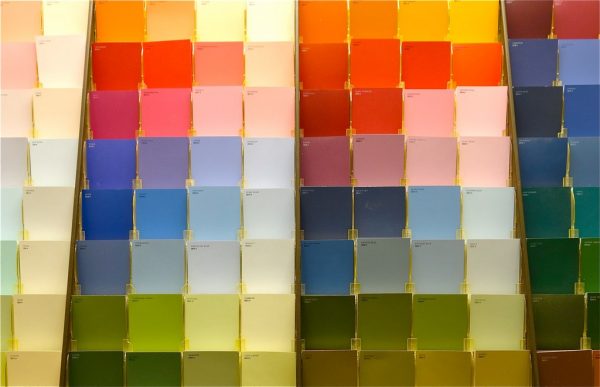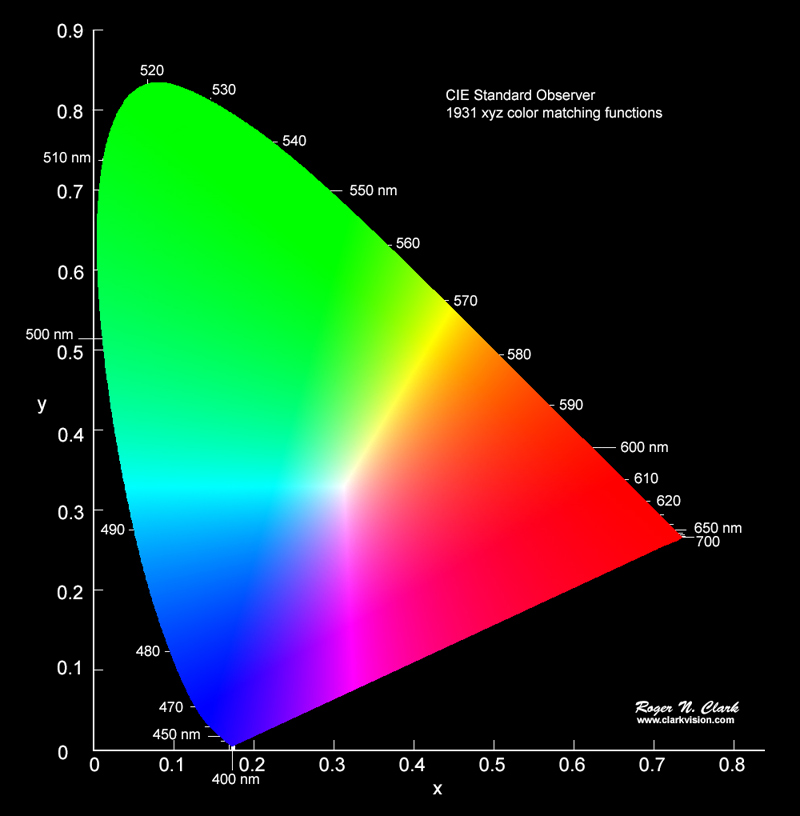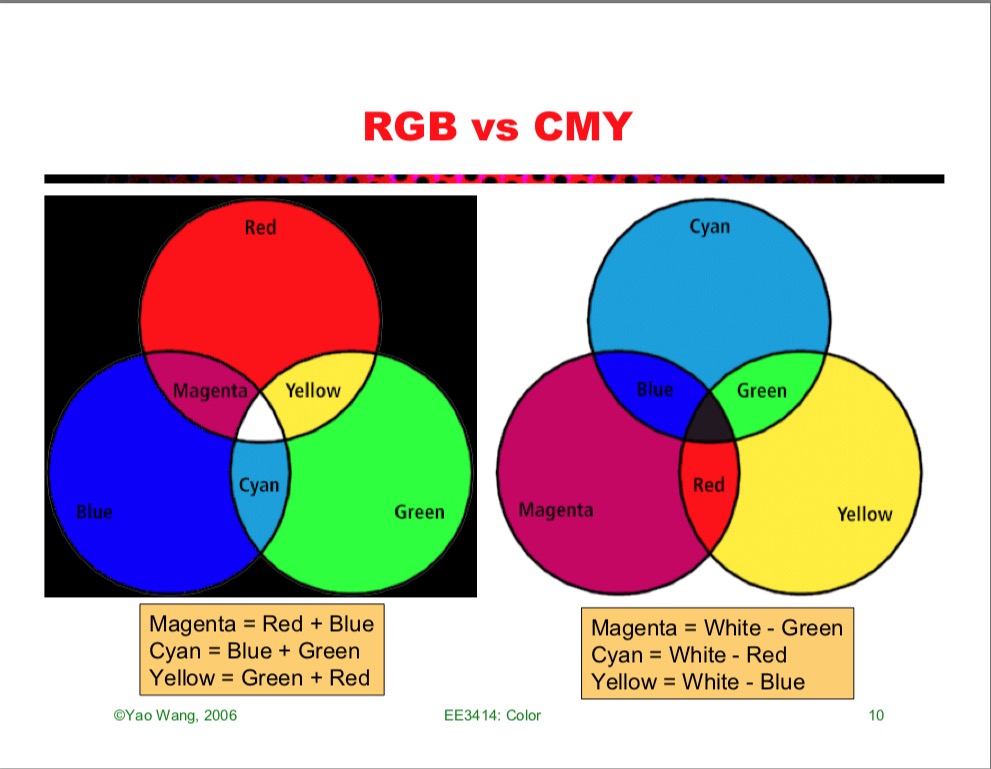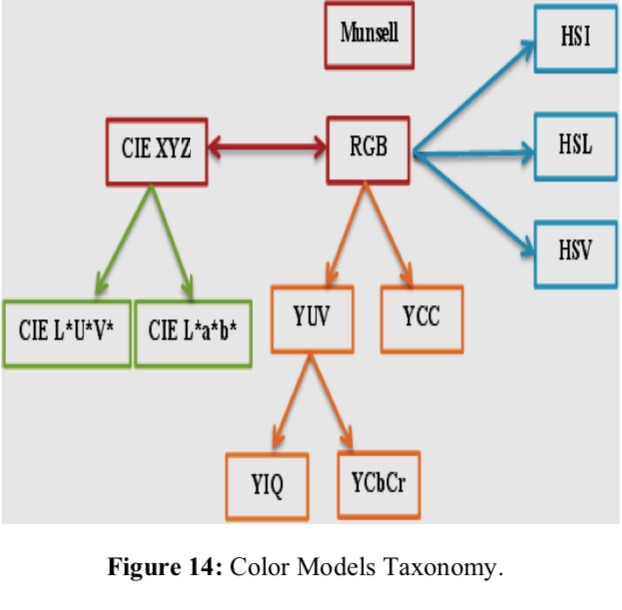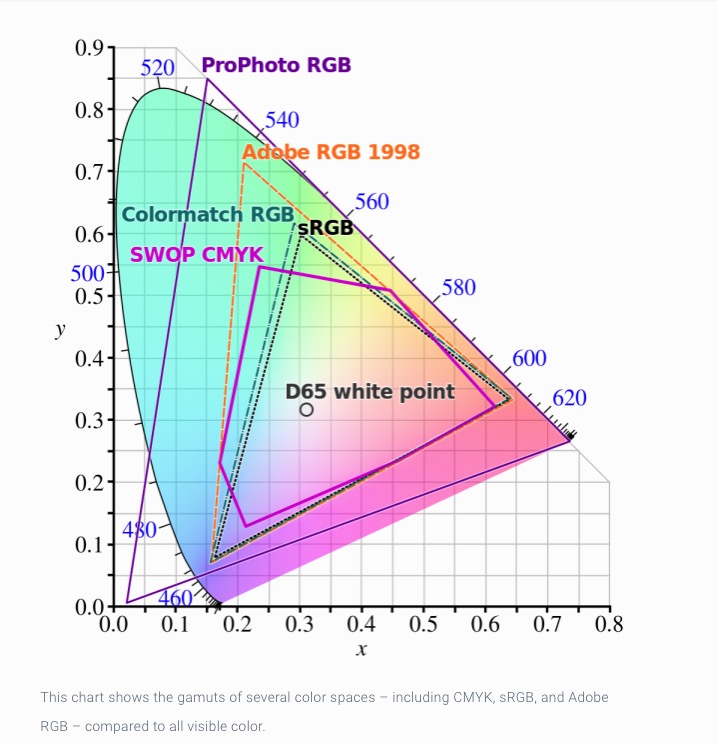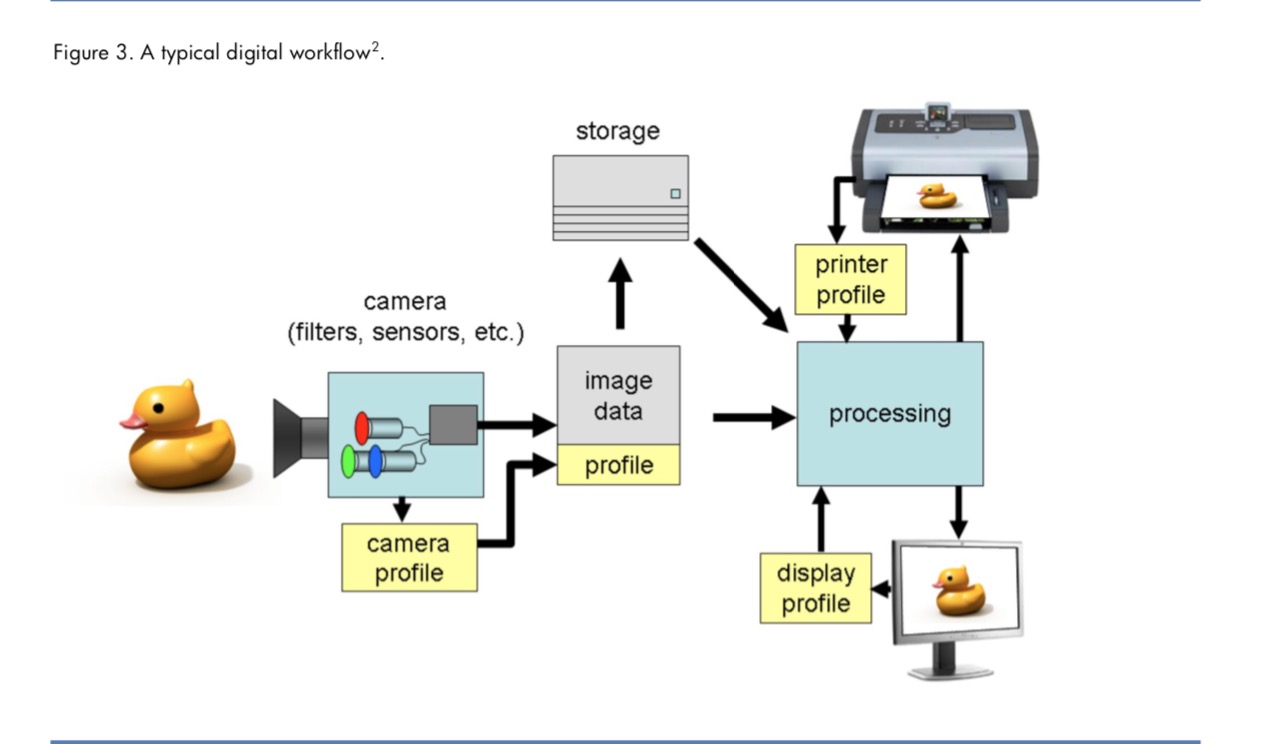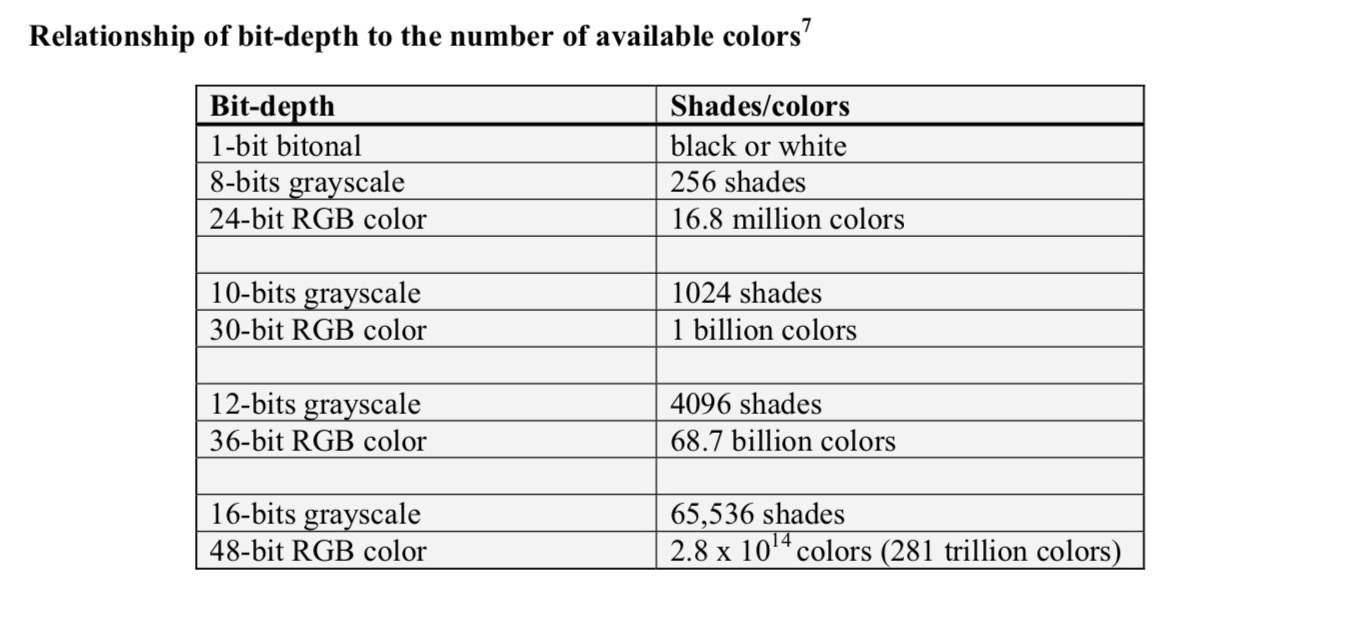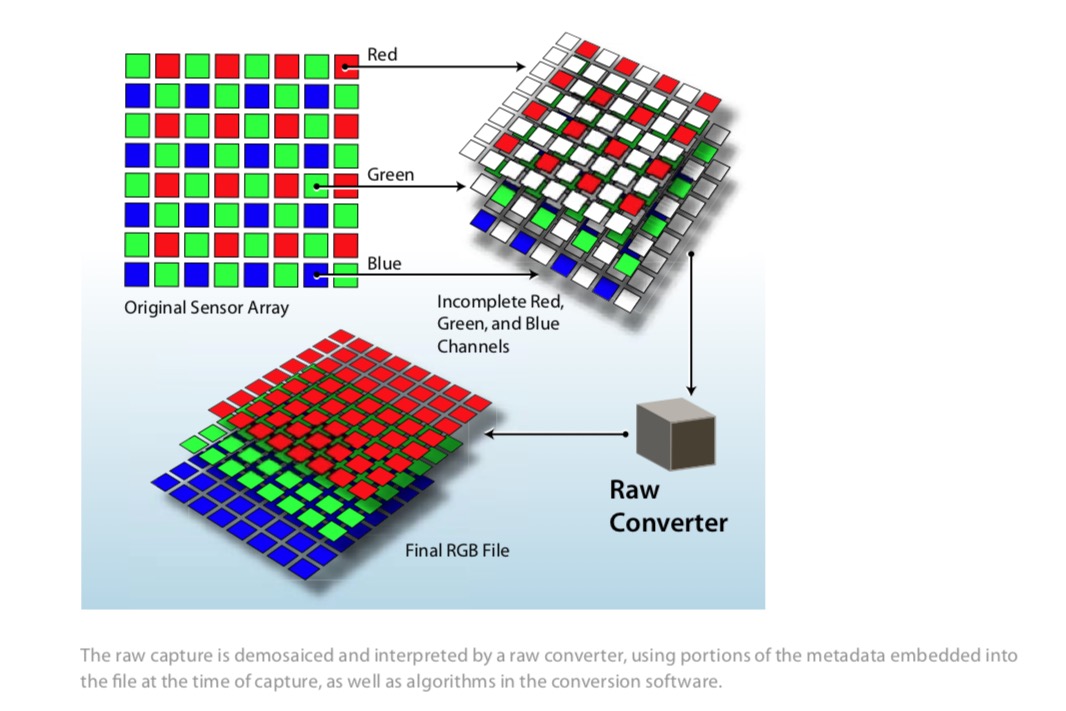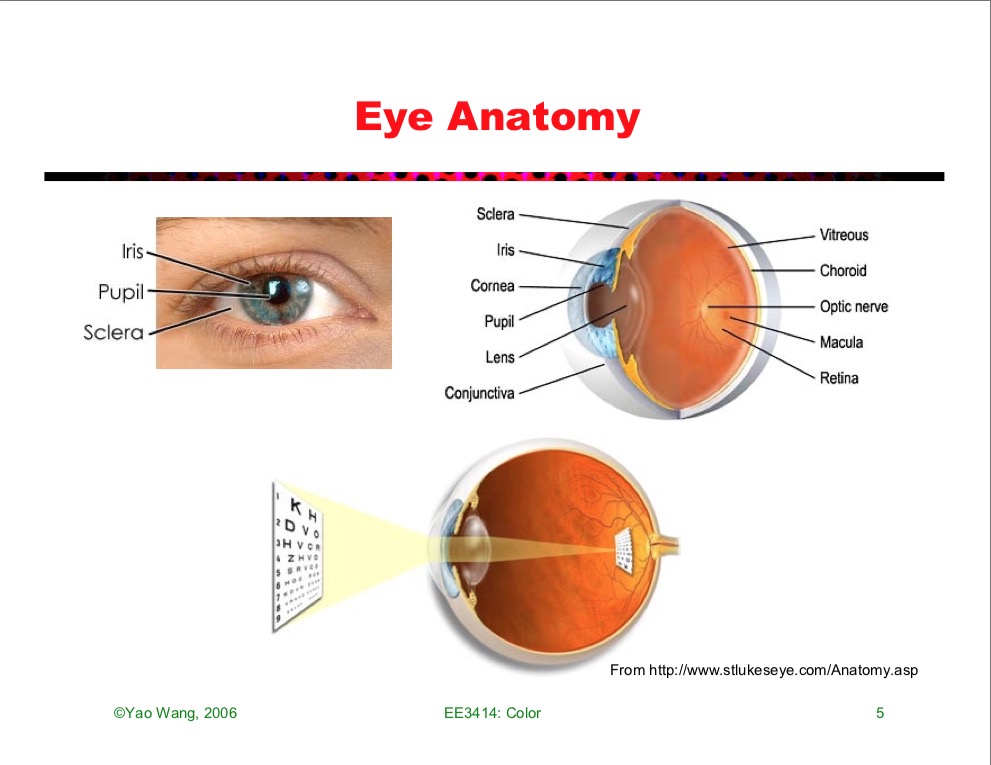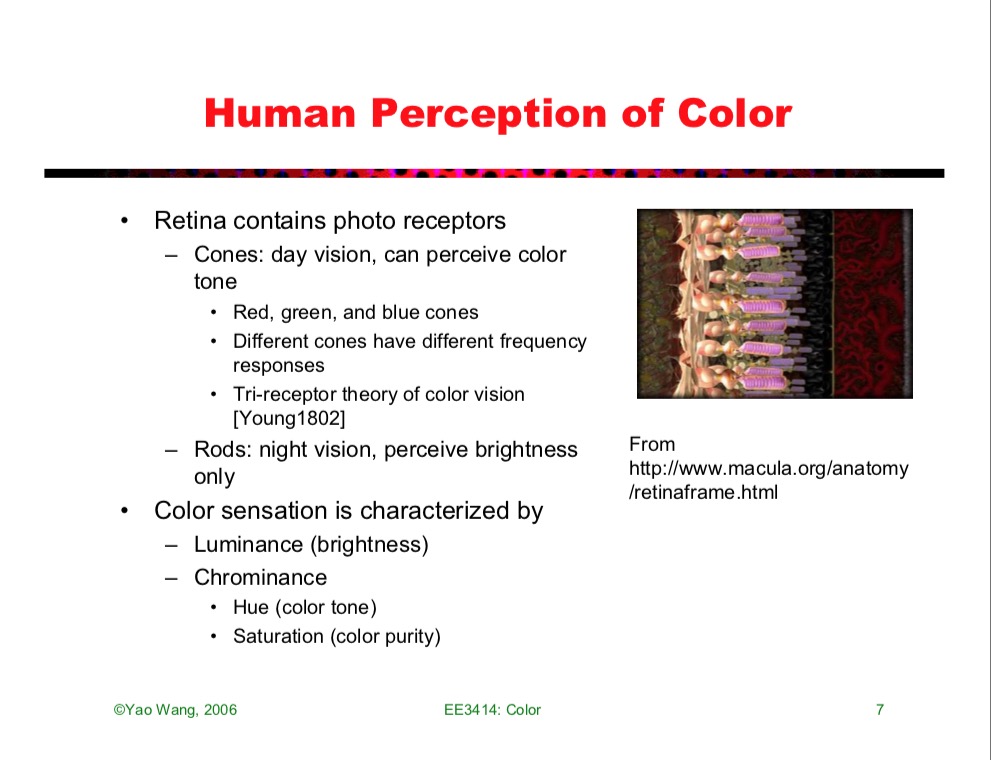
Color reproduction and management is a key task in digital video and cinema production. Choices of hardware, software, and handoffs and handshakes in production process require control over color of an image or a video. This is a very complex task due to several reasons.
- Complexity of Color and its measurement
- Changing color and light conditions during shoot indoors and outdoors
- Hardware and software encoded color standards are inconsistent. Cameras, displays and projectors all have different color specifications.
- After shoot, the data recorded is processed using different softwares for editing, grading, compositing, CG rendering, animations, and special effects. These softwares require different data formats (Log vs Linear).
- After processing video data is required to meet different deliverables in multiple formats for displays and projectors.
- Archiving and storage of data requires specific color formats.
- There are also subjective and artistic requirements to meet look and feel of the data.
My post is to bring these issues to light and to educate. I hope after reading this post you know little more about color and its management during digital video and cinema production.
Key Terms
- ACES
- LUT
- REC709
- REC2020
- Color Gamut
- CIE Chromaticies
- CIE XYZ
- ACES 1.1
- ACES 1.2
- Color Workflow
- Premier Pro
- Final Cut Pro
- Davinci Resolve
- Avid Media Composer
- IDT
- ODT
- RRT
- Maya
- Nuke
- After Effects
- ITU
- SMPTE
- AECS
- ACES AP0
- ACES AP1
- BT 709
- BT 2020
- BT 2100 in 2016 to include HDR
- HDR High Dymanic Range
- HDR 10
- SLog3
- Fusion
- Resolve
- After Effects
- OCIO
- IDT
- ODT
- RRT
- Red
- Arri
- Sony
- Canon
- Octane
- CG
- Linear representation of light
- Gamma Curve
- Log Gamma Curve
- Log Profiles
- Dynamic Range
- Linearize work flow
- Wide Gamut color space
- Rendering engines
- VRay
- Arnold
- Redshift
- Octane
- Cinema 4d
- Blender
- EXR linearize
- Reference Rendering Transform
- Color Manager OCIO
- SLog
- ACES CC
- ACES CCT
- Wave Form
- DaVinci Resolve
- After Effects
- FS7
- Rushes
- Academy of Motion Picture Arts and Sciences
- American Society of Cinematographers ASC
- Digital Cinema Initiatives DCI
- Society of Motion Picture and Television Engineers SMPTE
- OpenColor IO
- 32 bit per channel
- 8 Bit
- ACES CG Input
- REC 709 Output
Human Vision
Source: https://z-fx.nl/ColorspACES.pdf

Color Models of Human Vision
Please see my two previous posts.
On Light, Vision, Appearance, Color and Imaging
Digital Color
Source: What is 4K, UHD, SLog3, Rec 2020
The process of capturing and reproducing images requires a collaboration of camera sensors, file formats, rendering technologies, and display or printer technologies. All of these have different ways and different capabilities of representing color and intensity. In addition, they are all different from how our eyes work which further complicates things. As a result, over the years, several standards and processes have been implemented to accomplish this. They all involve some aspects of how to capture and store colors, what range of colors can be dealt with and how to adjust intensity to best reproduce the real world. To understand the new 4k technologies, including SLOG3, HDR, Rec 2020 etc, an understanding of the following is needed.
- Gamut
- Bit Depth
- Gamma
- Gamma Correction
- Color spaces
Color Gamut
Source: https://z-fx.nl/ColorspACES.pdf
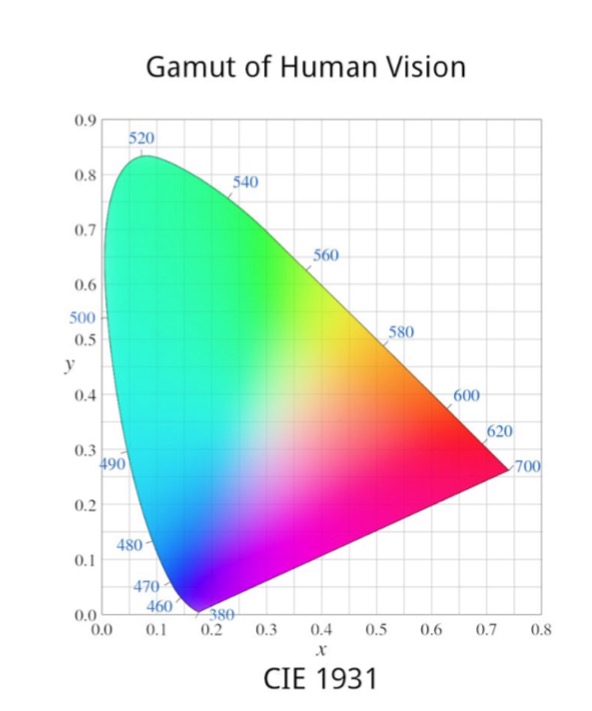
Color Capture in Digital Video and Cinema
Source: HOW DOES A DIGITAL CAMERA SENSOR WORK?
A modern digital camera’s sensor comes in one of two varieties generally. It will either be a Complementary Metal Oxide Semiconductor (CMOS), or a Charge-Coupled Device (CCD) sensor. The CCD type is mainly used in older models, but is still used on some modern cameras. Each type has its own advantages and disadvantages, but that is a topic for another article.
The most basic way you can understand how a sensor works is when the shutter opens, the sensor captures the photons that hit it and that is converted to an electrical signal that the processor in the camera reads and interprets as colors. This information is then stitched together to form an image. That is insanely over-simplified though.
The more complex answer is that a sensor is made up of millions of cavities called “photosites,” and these photosites open when the shutter opens and close when the exposure is finished (the number of photosites is the same number of pixels your camera has). The photons that hit each photosite are interpreted as an electrical signal that varies in strength based on how many photons were actually captured in the cavity. How precise this process is depends on your camera’s bit depth.
If we looked at a picture that was taken with just that electrical data mentioned earlier from the sensor, then the images would actually be in gray-scale. How we get colored images is by what’s known as a “Bayer filter array.” A Bayer filter is a colored filter placed over-top of each photosite and is used to determine the color of an image based on how the electrical signals from neighboring photosites measure. The colors of the filters are the standard red, green and blue, with a ratio of one red, one blue and two green in every section of four photosites.
The red filter allows red light to be captured, the blue allows blue light in and the green allows green light in. The light that doesn’t match that photosites filter is reflected. This means that we are losing two-thirds of the light that can be captured and it is only of one color for each photosite. This forces the camera to guess what the amount of the other two colors is in each given pixel.
The data that is interpreted by the sensor with the Bayer filter array is what a RAW image file is.
The camera then goes through a process to estimate how much of each color of light there was for each photosite and colors the image based on that guessing.
Single Sensor Vs Multiple Sensors in Cameras
- Sensor Type
- CCD
- CMOS
- Sensor Size
- Full Frame
- APS-C
- Sensor Numbers
- Single – 1 CMOS or 1CCD
- Multiple – 2CCD, 3CCD, 3CMOS
- Sensor Pixels
- 24 MP
- 48 MP
- Sensor Dynamic Range
- Range of brightness sensor captures
- 14 Stops
- 20 Stops
A camera sensor can only capture a limited range of light. When a scene extends beyond that range of light, techniques such as filters, flash, and editing techniques can still create a dramatic, well-detailed image.
Comparison of different sensor sizes
Image Source: Camera Sensor Sizes Explained: What You Need to Know
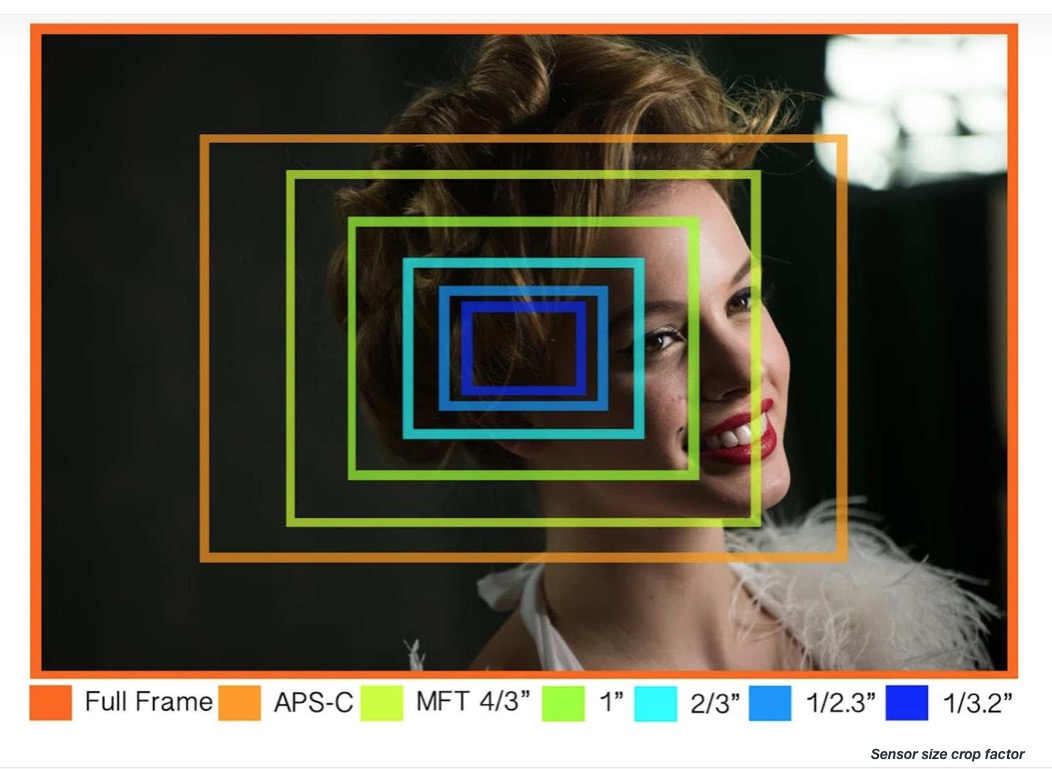
Source: Camera Sensor Sizes Explained: What You Need to Know

Cameras with Single Image Sensor
With CFA Color Filter Array
- Bayer CFA
Bayer CFA
Source:
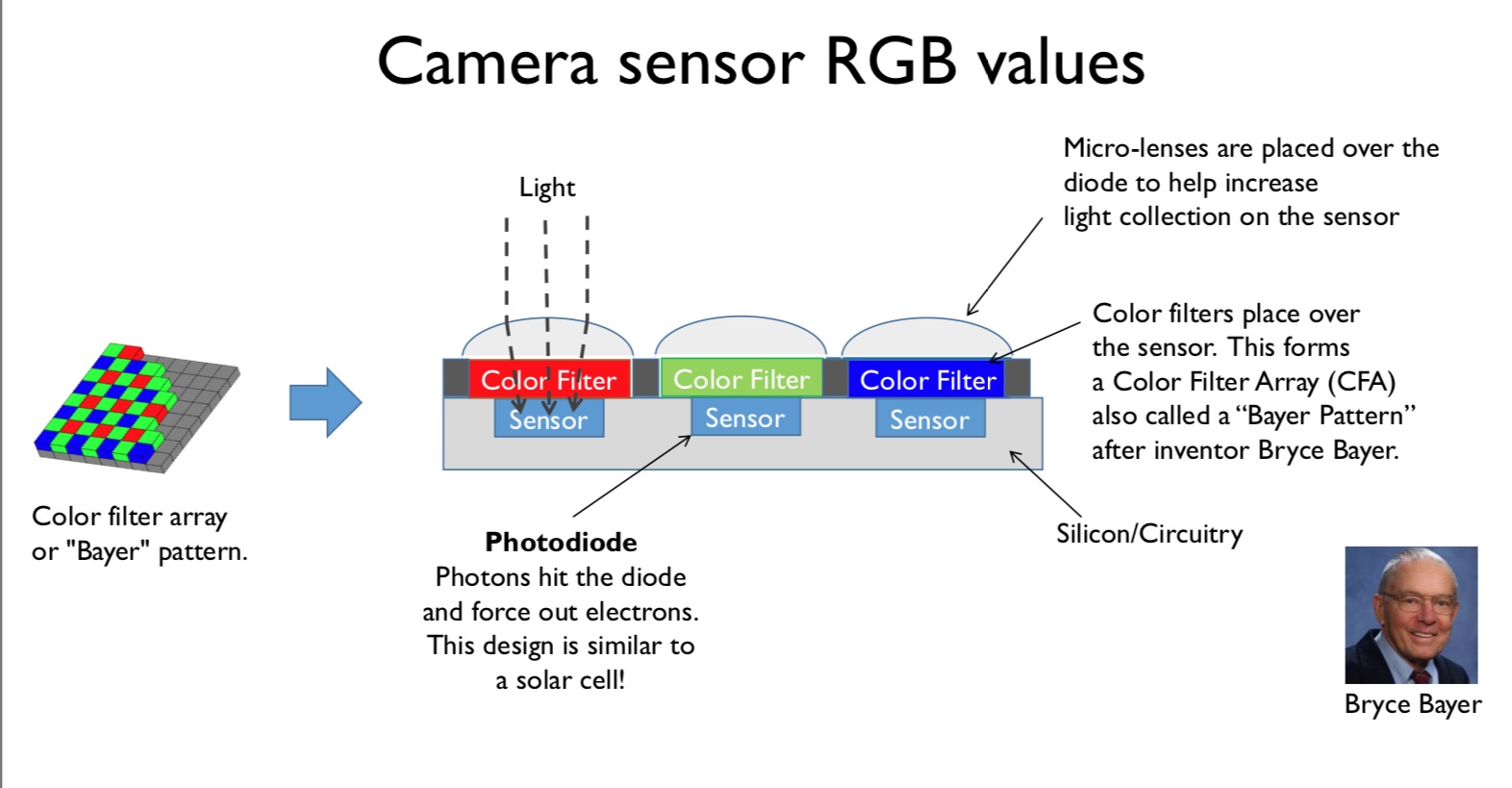
Conversion of RAW files
Source: https://z-fx.nl/ColorspACES.pdf

Cameras with multiple Image Sensors
Cameras with multiple sensors do not require Bayer CFA.
- 3 CCD – Single color info per sensor
- 3 CMOS – Single color info per sensor
- 4 CCD – Single color info per sensor plus Near Infra Red (NIR) info
Color Spaces in the Digital Video and Cinema
Image Source: Common Color Spaces
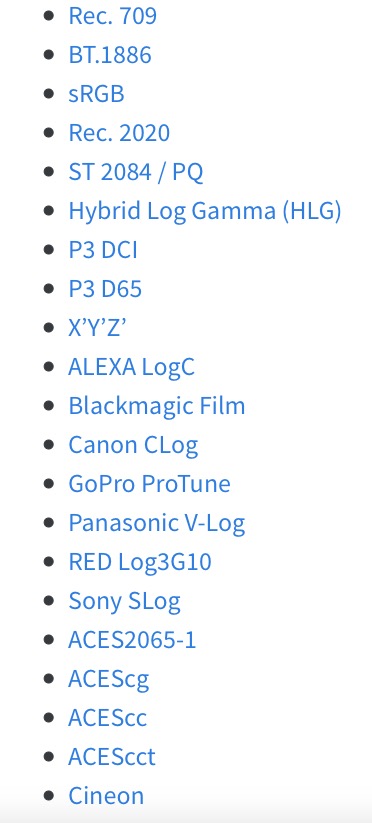
Gamut of Color Spaces
Color Space is characterized based on how much of its gamut covers the CIE Chromaticity Diagram.
Image Source: Why Every Editor, Colorist, and VFX Artist Needs to Understand ACES
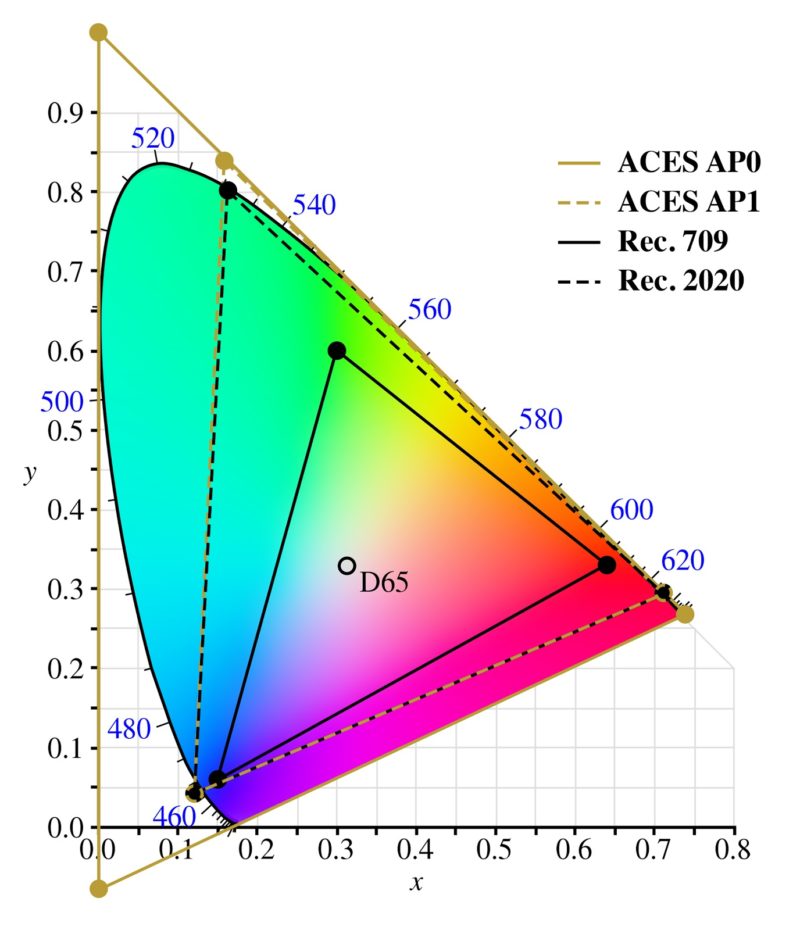
Source: The Pointer’s Gamut
The coverage of real surface colors by RGB color spaces and wide gamut displays
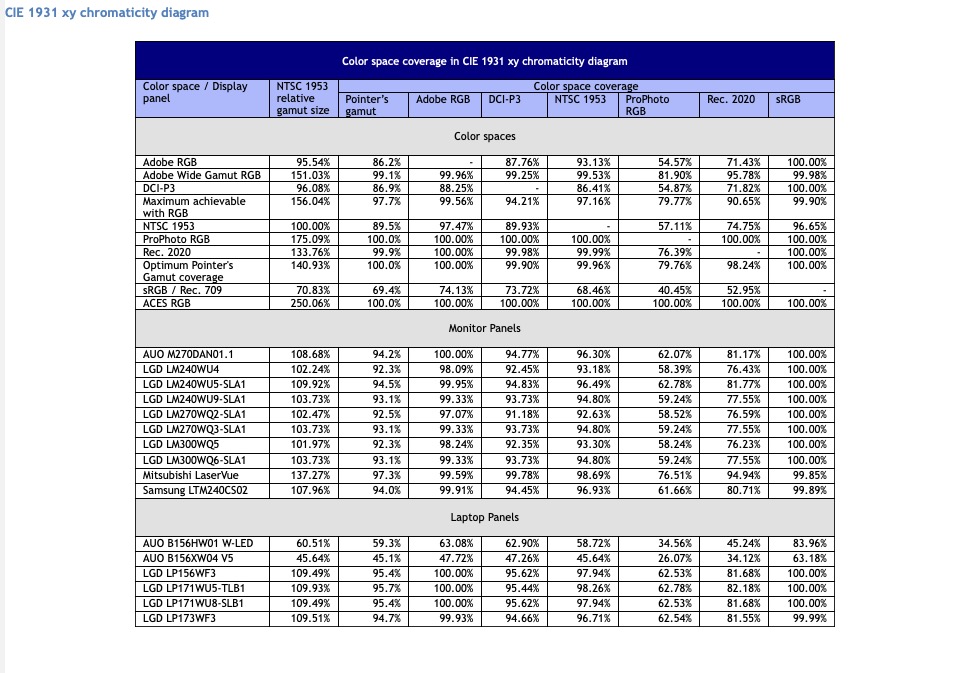
Source: The Pointer’s Gamut
The coverage of real surface colors by RGB color spaces and wide gamut displays

Device Dependent Color Spaces
Capture Devices
Professional Cameras for Cinematography and Videography from
- Sony
- Canon
- Arri
- Red
Camera Sensor Dynamic Range
Image Source: Understanding 4K, Ultra HD and HDR

Conversion of RAW to Video Formats
Image Source: Understanding 4K, Ultra HD and HDR

Sony SLog Transfer Function
Image Source: Understanding 4K, Ultra HD and HDR

Sony Transfer Functions
Image Source: Understanding 4K, Ultra HD and HDR

Other Transfer Functions
Image Source: Understanding 4K, Ultra HD and HDR
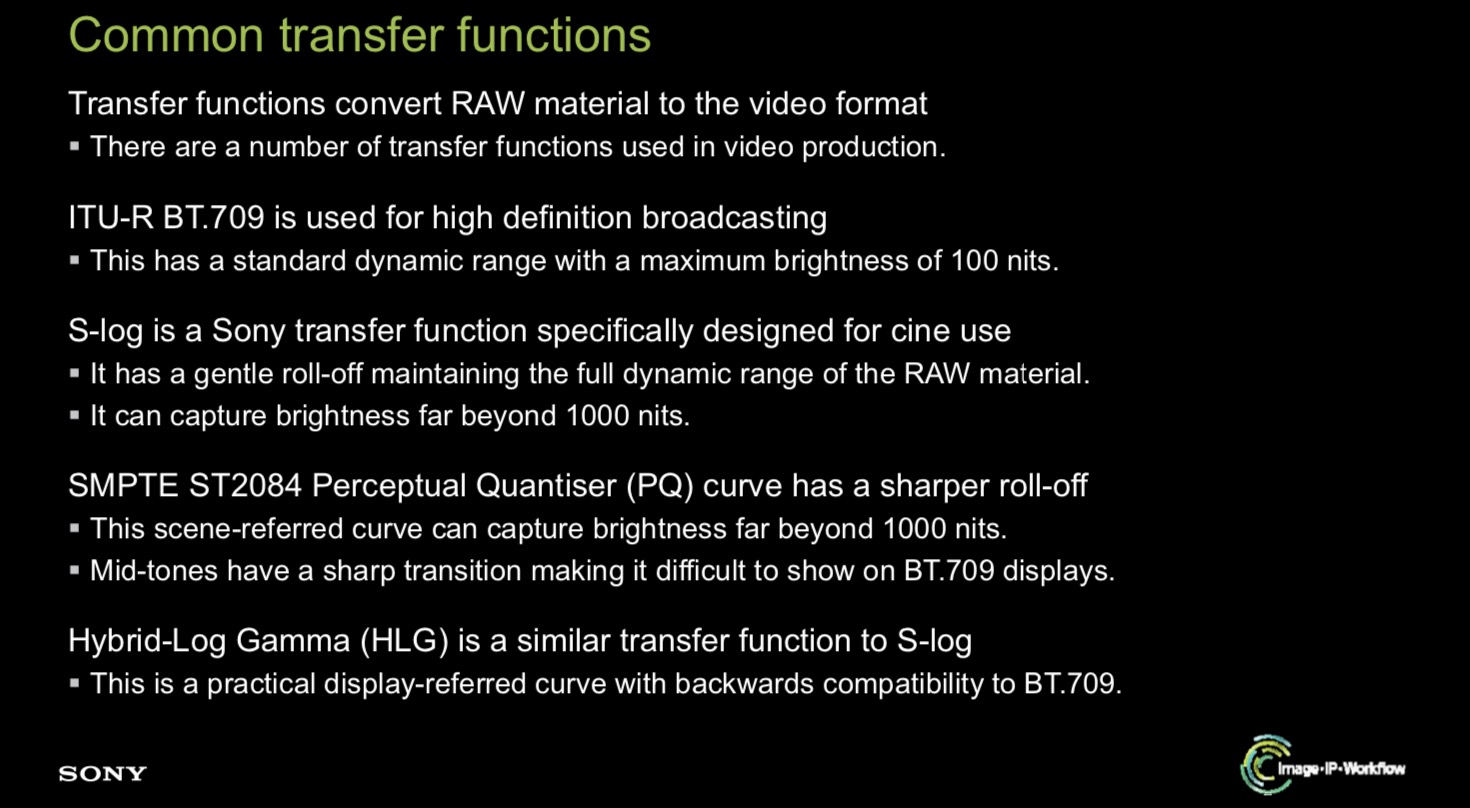
Sony Color Spaces
Image Source: Understanding 4K, Ultra HD and HDR

Slog, Gamma, and Gamut
Source: Are S-Log and Color Space separate things?
S-log is a specific gamma, color space is a general term referring to gamuts. A very crude way of thinking is gamma refers to brightness and gamut refers to color.
It’s important to know which gamma and gamut you are recording in as this helps to ensure there is correct gamma and gamut mapping from capture to exhibition.
What is Gamma?
Gamma is also called Tone Mapping.
Source: What is 4K, UHD, SLog3, Rec 2020
Each pixel has a brightness level, which is the average of {red, green, blue} values, and this is called its luminance. In order to reproduce an image from capture to display, the luminance needs to be accurately reproduced. Since sensors and displays can have different luminance characteristics, there needs to be a mapping or relationship between a pixel’s numerical values and the actual luminance…this relationship is called the Gamma.
Linear Space is counter to Gamma Space or Log Space.
Log Space or Gamma Space
Log Curve simulates a non-linear curve. Log Color Profiles can be created for a camera.
- Arri LogC
- Cineon Dpx
- RedLogFilm
- Canon-Log
Source: LOG COLOR IN-DEPTH
Every professional camera manufacturer and almost every VFX and grading package has a Log workflow. Camera companies such as Arri, Sony, Canon, Red and many others implement their own flavors of Log color space. With the Log workflow it is possible to fit more dynamic range into an image and simulate nonlinear film response to light. The term Log is derived from the word logarithm, which is a fancy name for a function which outputs exponents for the given number.
Log Spaces of Different Brands
Source: LOG COLOR IN-DEPTH

Gamma Curve = Tone Curve = Log Curve
Log footage is an important part of the post-production workflow. Here’s what you need to know.
Source: UNDERSTANDING LOG AND COLOR SPACE IN COMPOSITING
As digital filmmaking becomes more and more affordable, technologies become increasingly available to colorists or post-production professionals. In this case, Log footage. The Log (logarithmic) color space has been around for quite a while. Initially high-end post houses used it with scanned film negatives in a color space called Cineon Log. Now, pretty much all camera manufacturers offer their own Log curve (or multiple). There is S-Log 2&3 (Sony), LogC (Arri), Canon Log, V-Log (panasonic), Red Logfilm, Blackmagic Log, etc. Each of them are different, usually tailored for the color science of the particular manufacturer’s products.
The biggest reason to use the Log color curve is how it retains the most dynamic range of information from the camera sensor (or film negative). It encodes what the camera sees logarithmically, meaning that the correlation between the exposure of the image (measured in stops) and the recorded image is completely constant over a wider range. It utilizes more of the sensor’s information than a standard video curve because it’s saving as much data as possible rather than capturing specifically for the human eye or a video screen. This gives you much more color data to work with in post-production.
Linear Space
Source: Color Management/Blender
For correct results, different Color Spaces are needed for rendering, display and storage of images. Rendering and compositing is best done in scene linear color space, which corresponds more closely to nature, and makes computations more physically accurate.
Log Space to Linear Space Conversion
Source: LOG COLOR IN-DEPTH
In conclusion, to bring an image into the log color space all we need to do is to apply a logarithmic function which transforms values of pixels based on the log curves above. To linearize a log picture, we use an exponent function. Since the log color space is a mathematical transformation of values of pixels, it can be used with any types of file format, bit depth and channel.
White Point
Is the color temperature of light. Outdoors, Indoor, Sunny, Cloudy conditions affect White Point. In Cameras white point can be adjusted depending on light conditions. D65 simulates daylight.
- D50 – 5000 K
- D60 – 6000 K
- D65 – 6500 K
sRGB uses D65 vs ACES uses D60.
Source: https://z-fx.nl/ColorspACES.pdf
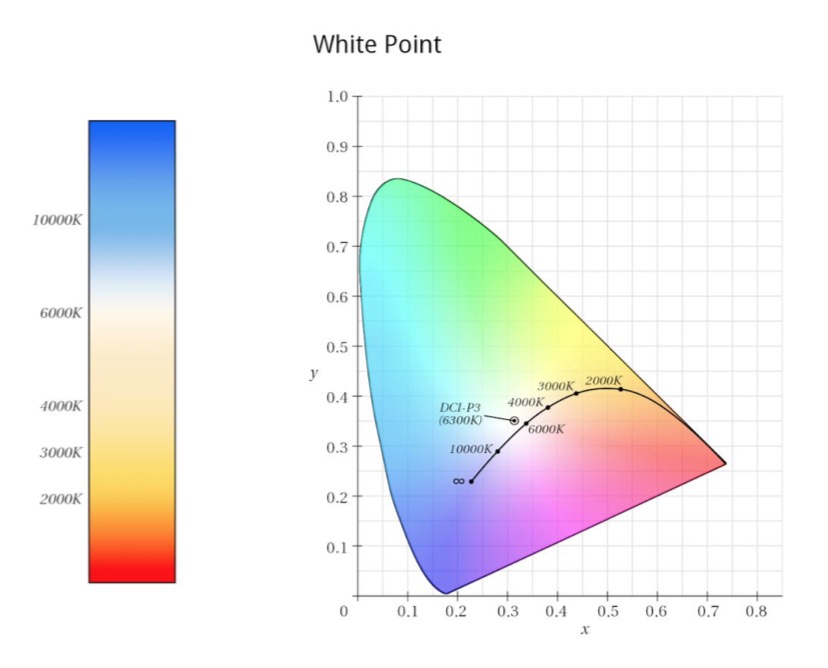
So do you understand these now?
- LUT (Look Up Tables)
- EOTF (Electro-Optical Transfer Function) – Linear to Non Linear or Log Conversion
- OETF (Optio-Electro Transfer Function) – Log to Linear Conversion
- Gamma Curve – Popular Name for EOTF
- Gamma Correction
- Log Curve (Non Linear Data)
- Linear Curve (Linear Data)
- High Dynamic Range HDR
- Standard Dynamic Range SDR
- White Point
- IDT – Input Data Transform
- ODT – Output Data Transform
- Log LUT
- f-Stops
A pair of Gamma and Gamut data is requied for encoding to display colors.
A device dependent RGB color space has standard primaries, gamma, and a whitepoint such as D50 or D65.
- Primaries (R G B) for Color
- Gamma for Luminance, and
- White Point
Source: The Essential Guide to Color Spaces
Now that we’ve discussed these three parameters, here are some practical examples:
An Arri Alexa records media in Arri Wide Color Gamut, with an Arri Log C tone mapping curve, and a white point ranging from 2,000K to 11,000K.
A RED Dragon captures media in RedWideGamutRGB gamut, with a Log3G10 tone mapping curve, and a white point ranging from 1,700K to 10,000K (other gamut and gamma choices are available).
A cinema projector has a DCI-P3 gamut, a Gamma 2.6 tone mapping curve, and a standard illuminant D63 white point.
An SDR TV has a Rec 709 gamut, a Gamma 2.4 tone mapping curve, and a standard illuminant D65 white point.
Display Devices
- Display Projectors
- Television
- Computer Monitors
Three advantages in newer display devices
- Color
- Color Space
- Bit Depth
- Gamma
- Gamma Correction
- Resolution
- 4K vs 8K
- Luminance
- Nits
Image Source: What is 4K, UHD, SLog3, Rec 2020

Color Spaces used in Display Devices
Image Source: What is 4K, UHD, SLog3, Rec 2020

Display Resolution
Image Source: WHAT IS 4K, UHD, SLOG3, REC 2020
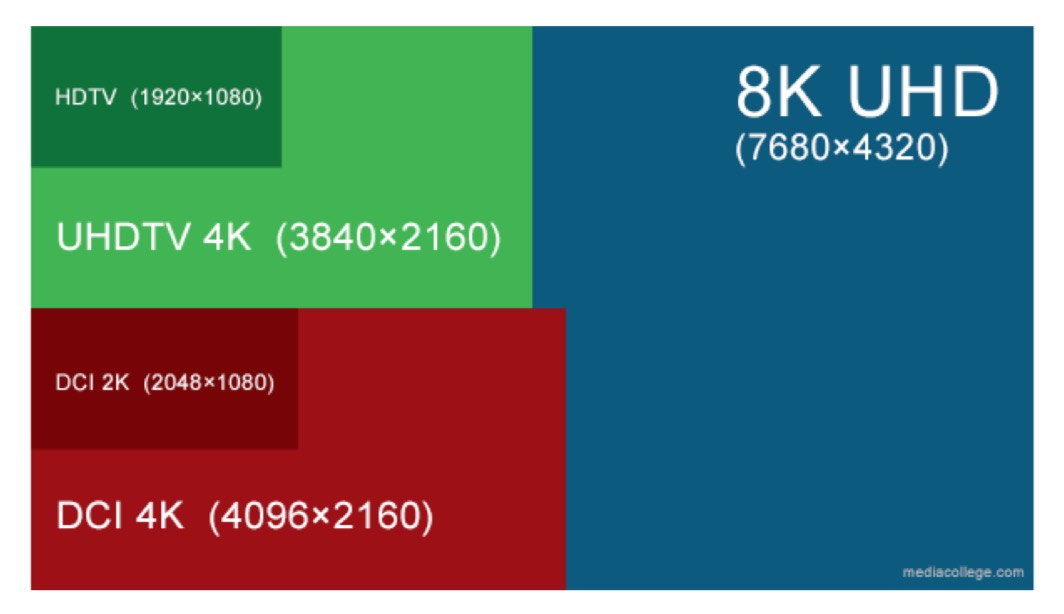
Bit Depth
Image Source: WHAT IS 4K, UHD, SLOG3, REC 2020
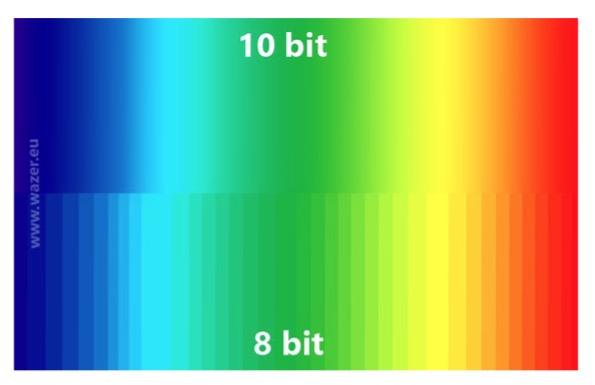
Color Specification using Color Management option in displays

Color Management in Digital Video and Cinema Production
In production of
- Feature Film
- Television
- OTT
- Live Production
SDR with REC 709 Color Space
Image Source: Understanding 4K, Ultra HD and HDR

SDR with S-Gamut3 and REC 2020
Image Source: Understanding 4K, Ultra HD and HDR

Process Flow
Image Source: Understanding 4K, Ultra HD and HDR
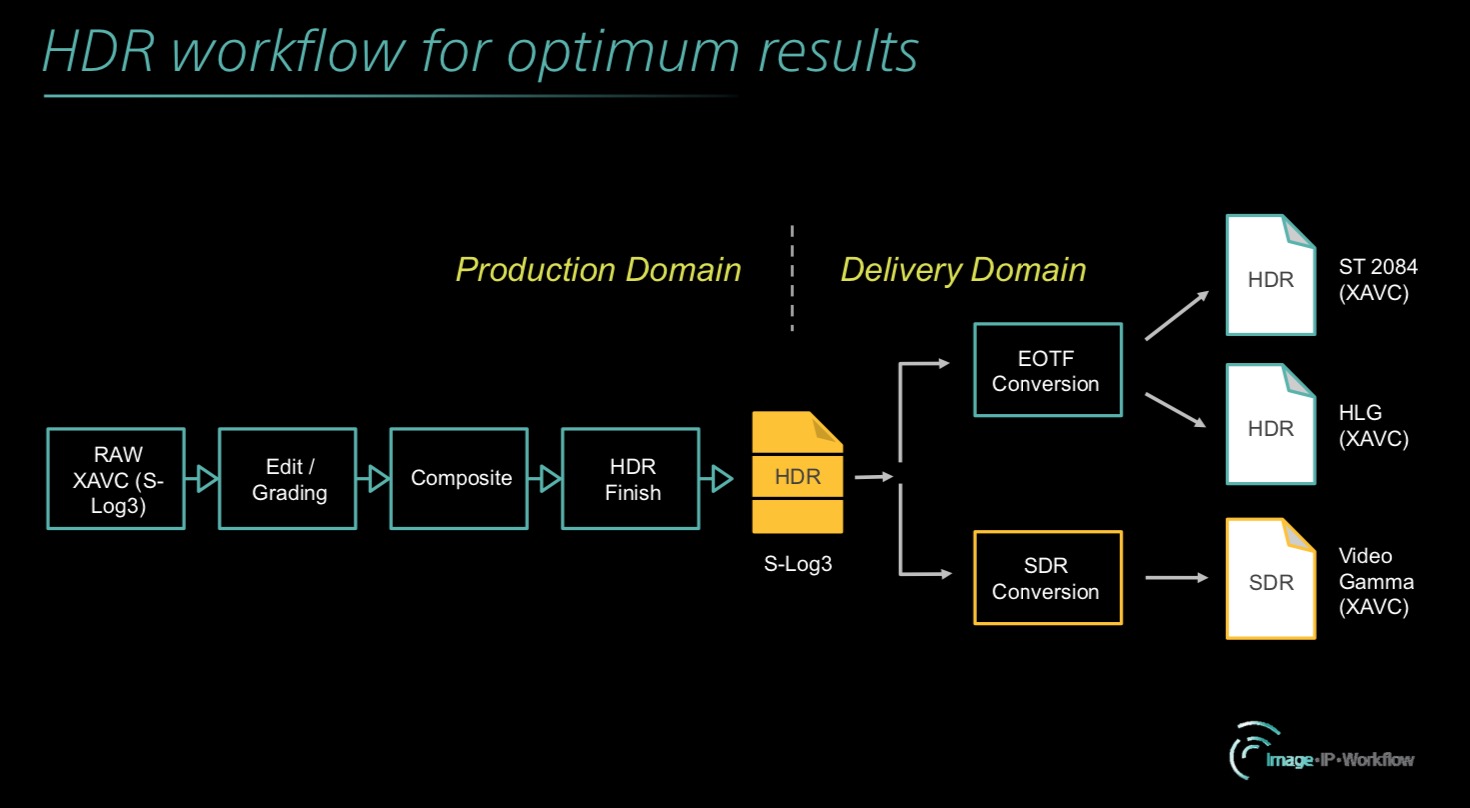
Live Production
Image Source: Understanding 4K, Ultra HD and HDR

Image Source: WHAT IS 4K, UHD, SLOG3, REC 2020

Operations during Production Process
- Shoot
- Convert
- Edit/Grading
- Conforming
- Compositing/Rendering/VFX/CG
- Convert
- Deliverables
Color Space Hierarchy in Process Flows
- Scene Referred – Input data has higher priority
- Display Referred – Output data has higher priority
Source: https://z-fx.nl/ColorspACES.pdf

Source:
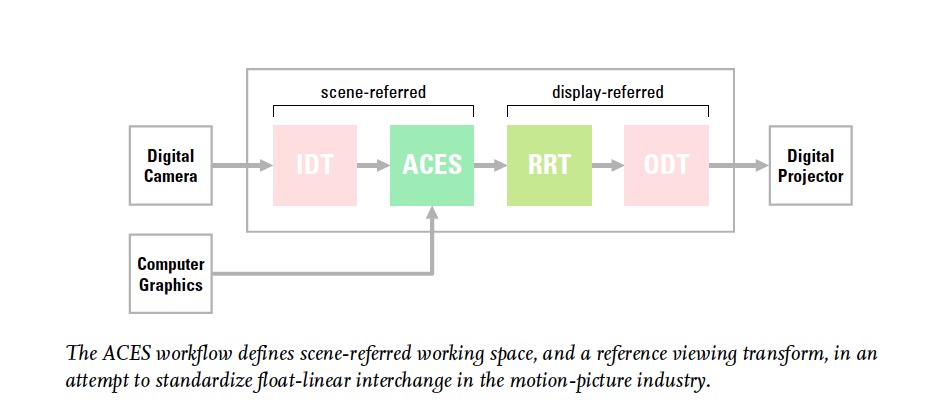
Process Flows in ACES
Source: https://z-fx.nl/ColorspACES.pdf

Source: https://z-fx.nl/ColorspACES.pdf

Working with ACES
Source: https://z-fx.nl/ColorspACES.pdf

CG and VFX Process Flows
Source: https://z-fx.nl/ColorspACES.pdf
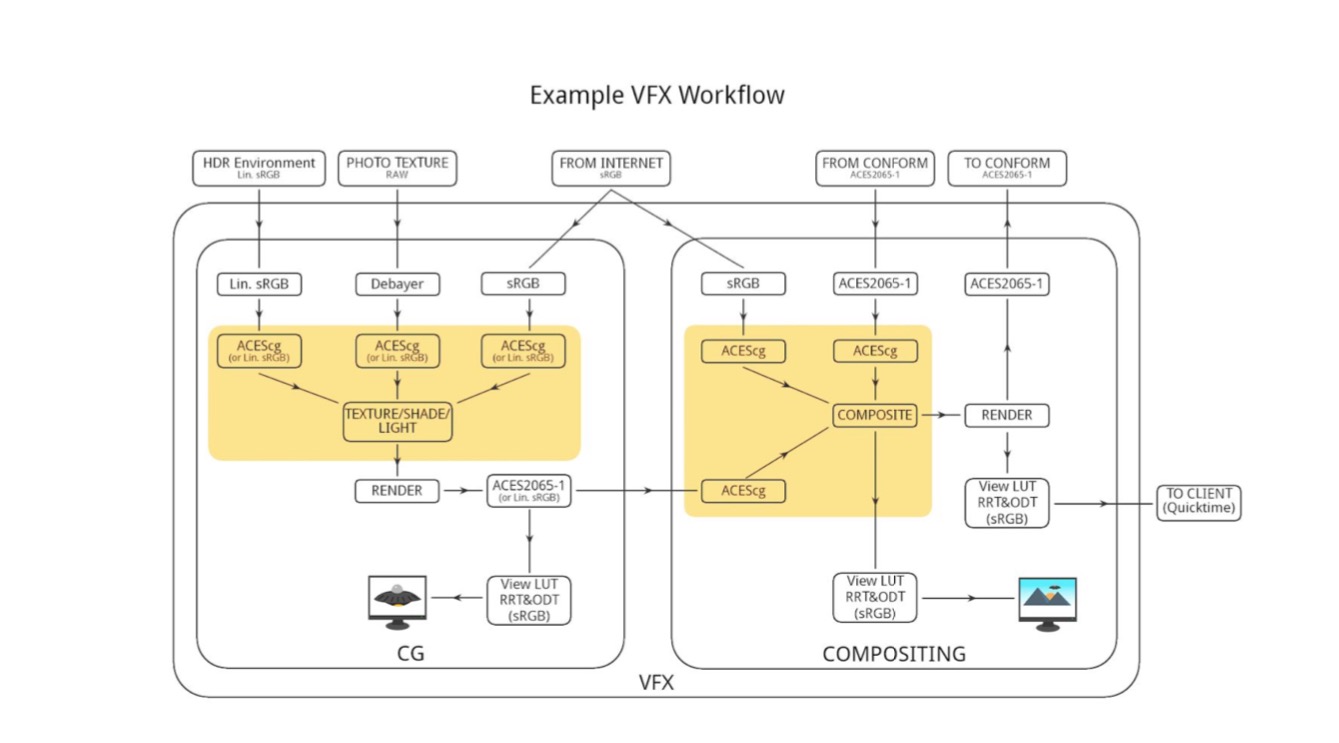
The ‘Parts’ Of ACES
Source: Why Every Editor, Colorist, and VFX Artist Needs to Understand ACES
Even though ACES and its various transforms are quite mathematically complex, you can understand ACES better by understanding what each part or transform in the pipeline does.
Here’s the terminology for each of these transforms:
ACES Input Transform (aka: IDT or Input Device Transform)
The Input Transform takes the capture-referred data of a camera and transforms it into scene linear, ACES color space. Camera manufacturers are responsible for developing IDTs for their cameras but the Academy tests and verifies the IDTs. In future versions of ACES, the Academy may take on more control in the development of IDTs. IDTs, like all ACES transforms, are written using the CTL (Color Transform Language) programming language. It’s also possible to utilize different IDTs to compensate for different camera settings that might have been used.
ACES Look Transform (aka: LMT or Look Modification Transform)
The first part of what’s known as the ACES Viewing Transform (the Viewing Transform is a combination of LMT, RRT, & ODT transforms). LMTs provide a way to apply a look in a similar way to a Look Up Table (LUT). It’s important to note that the LMT happens after color grading of ACES data. Also, not every tool supports the use of LMTs.
RRT (Reference Rendering Transform)
Think of the RRT as the render engine component of ACES. The RRT converts scene referred linear data to an ultrawide display-referred data set. The RRT works in combo with the ODT to create viewable data for displays and projectors. While the Academy publishes the standard RRT, some applications have the ability to use customized RRTs (written with CTL). But many color correction systems do not provide direct access to the RRT.
ACES Output Transform (also known as the ODT or Output Device Transform)
The final step in the ACES processing pipeline is the ODT. This takes the high dynamic range data from the RRT and transforms it for different devices and color spaces. Like P3 or Rec 709, 2020, etc. Like IDTs and RRTs, ODTs are written with CTL.
Derivative Standards
Source: Why Every Editor, Colorist, and VFX Artist Needs to Understand ACES
There are also three main subsets of ACES used for finishing workflows called ACEScc, ACEScct and ACEScg:
- ACEScc uses logarithmic color encoding and has the advantage of making color grading tools feel much more like they do when working in a log space that many colorists prefer.
- ACEScct is just like ACEScc, but adds a ‘toe’ to the encoding. This means that lift operations respond similarly to traditional log film scans. This quasi-logarithmic behavior is described as being more milky, or foggier. ACEScct was added with the ACES 1.03 specification. It’s meant as an alternative to ACEScc based on the feedback of many colorists.
- ACEScg utilizes linear color encoding and is designed for VFX/CGI artists so their tools behave more traditionally.
The ACES Pipeline
Source: Why Every Editor, Colorist, and VFX Artist Needs to Understand ACES
Now that we’ve defined the transforms used for ACES, understanding how the various transforms combine to form an ACES processing pipeline is pretty straightforward:
Camera Data -> Input Transform -> Color Grading -> Look Transform (optional) -> Reference Rendering Transform -> Output Transform
As mentioned, ACES is a hybrid color management system of scene referred/scene linear and display referred data.
Source: Why Every Editor, Colorist, and VFX Artist Needs to Understand ACES
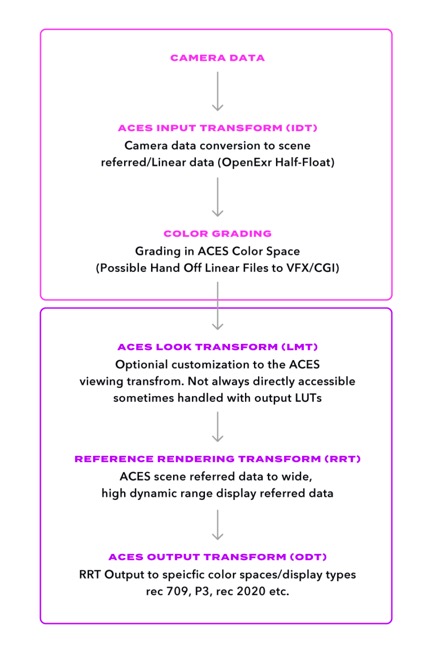
Source: COLOUR MANAGEMENT BASICS
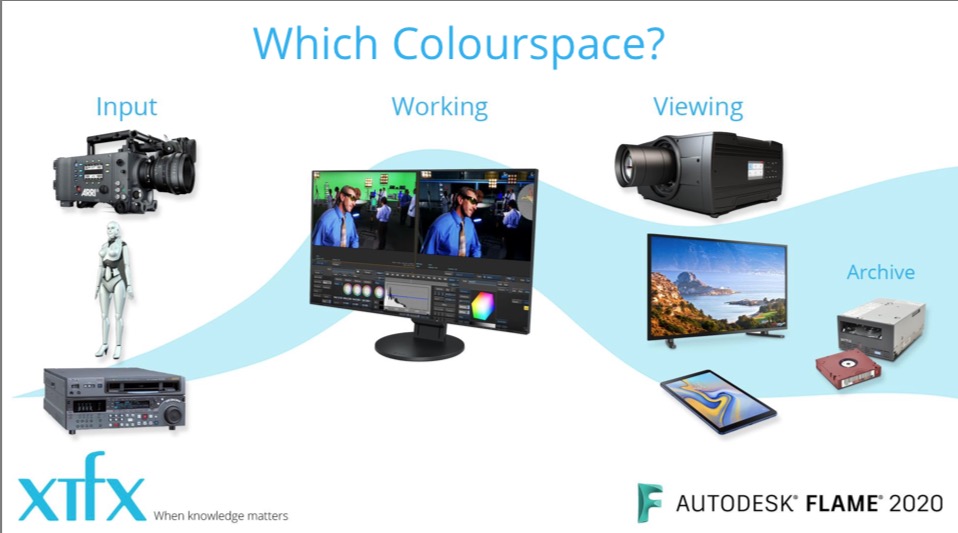
Source: COLOUR MANAGEMENT BASICS

Source: COLOUR MANAGEMENT BASICS
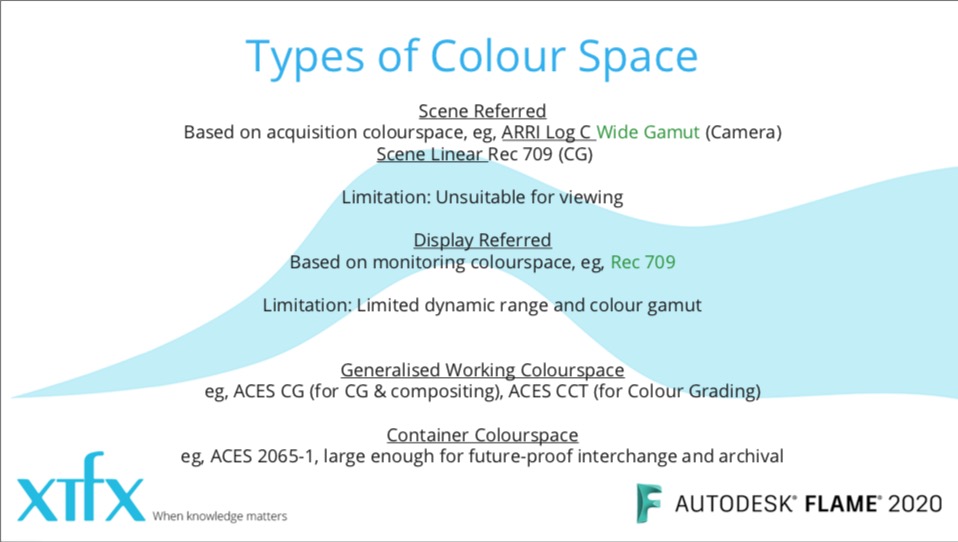
Source: COLOUR MANAGEMENT BASICS/Autodesk

Color Throttle
Because of bottlenecks in hardware and software, the color captured during the image/video capture process does not flow in its entirty to the displays of the users. Use of hardware and color spaces used during production process determines the output displayed. Color is thus throttled.
Color Throttle when using REC 709 Color Space
Image Source: BT.2020: How the Newest Color Range Standard Maximizes 4K Video Quality

Color Throttle when using REC 2020 Color Space
Image Source: BT.2020: How the Newest Color Range Standard Maximizes 4K Video Quality

Human Visual Dynamic Range Vs REC 2020 Range
Source: BT.2020: How the Newest Color Range Standard Maximizes 4K Video Quality

Source:
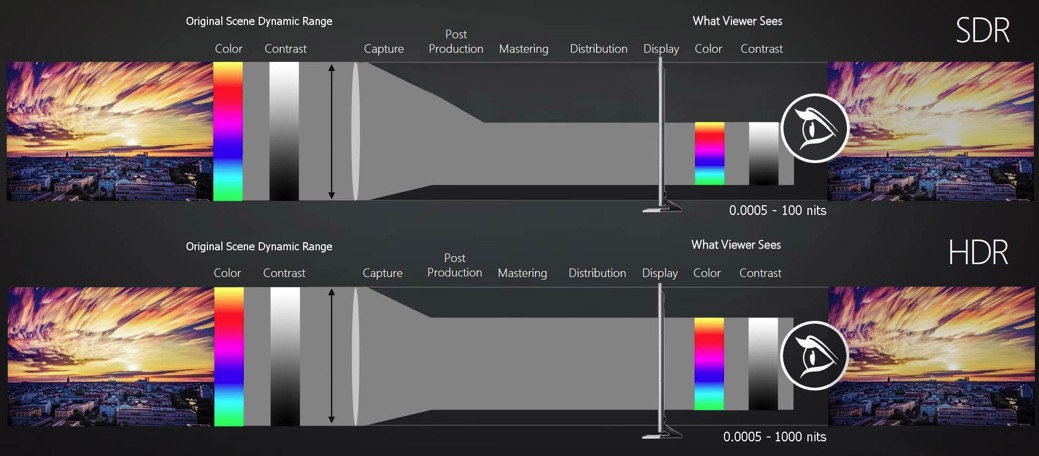
Softwares used in Post Production in Digital Video and Cinema
Source: digitalfilmpro.com
Video Editing Software and Hardware
- Non Linear Editor
- Avid Media Composer
- Adobe Premiere Pro
- Final Cut Pro
- DaVinci Resolve – color correction plus NLE
- Vegas Pro
- Digital Audio Workstation
- Avid Pro Tools
- Apple Logic Pro X
- Ableton Live 9
- Cakewalk Sonar
- Adobe Audition
- Close-Captioning and Subtitling
- Aegisub
- NLEs
- Edit Workstation
- Edit Computer
- Audio Equipment
- File Sharing
- KVM Extender
- Editing Keyboard
- Desk Chair
- Digital Audio Transcipts
Creative Apps
- RV
- Adobe After Effects
- Adobe Premiere Pro
- SideFX Houdini
- Unreal Engine
- Unity
- Perforce Helix Core
- Adobe Creative Cloud
- Adobe Illustrator
- Autodesk 3DS Max
- Autodesk Maya
- Autodesk RV
- Cinesync
- Connect
- Deadline
- Foundry Hiero
- Foundry Hiero Player
- Foundry Nuke
- Foundry Nuke Studio
- Maxon Cinema 4D
Free Video Editing Tools
- DaVinci Resolve
- Lightworks
- HitFilm Express
- Avid Media Composer First
- iMovie
Free Video Production Software Tools
- Audacity – multitrack audio recorder
- Ardour – DAW
- GIMP- image editing
- Blender – 3D Creation
- Nuke Studio – Compositor – Node Based visual FX (VFX), editing, and finishing Studio
- Blackmagic Fusion – Full feaured Compositor – Motion Graphics
3D Rendering Softwares
- Unity
- 3Ds Max Design
- Maya
- Cinema 4D
- Blender
- Keyshot
- V-Ray
- Lumion
- SOLIDWORKS Visualize
- Direct 3D
- RenderMan
- Redshift
- Octane Render
- Arnold
- Maxwell
Color Management in Applications
Source: DISPLAY CALIBRATION & COLOR MANAGEMENT

Cameras for Video
Budget Cinema Cameras
- Black Magic Pocket Cinema Camera
- Black Magic Pocket Camera 4K
- Z Cam E2C 4K Cine Camera MFT
- Panasonic GH5
Best Cameras for Videographers
Source: Best cameras for videographers/DPREVIEW.COM
Published Nov 24, 2020
- Panasonic Lumix DC – S1H
- Panasonic Lumix DC-GH5
- Canon EOS R6
- Fujifilm X-T4
- Nikon Z6
- Nikon Z6 II
- Panasonic Lumix Dc-GH5S
- Sigma fp
- Sony a7S III
Best 4K and 6K Cameras for Film making
Source: https://www.youtube.com/watch?v=o0muduTpveM&t=244s
- Sony Alpha a7 III
- Panasonic Lumix GH5S
- Sony PXW FSM2
- Panasonic Lumix S1H
- Blackmagic Pocket Cinema 6K
- Canon EOS C300 Mark II
- Panasonic AU-EVA1
- Blackmagic Design URSA Mini Pro G2
- Sony PXW FS9
- Canon C500 Mark II
Best Camcorders for Videographers
Source: Youtube
- Panasonic HC-X2000
- Sony PXW-Z280
- Canon XA55
- Panasonic AG-CX10
- JVC GY-HC500U
- Sony PXW-Z90
- Panasonic HC-X1
- Canon XF 705
- JVC GY-HM250
- Sony FDR -AX700
My Related Posts
On Light, Vision, Appearance, Color and Imaging
Key Sources of Research
Why Every Editor, Colorist, and VFX Artist Needs to Understand ACES
Working with ACES in DaVinci Resolve
https://digitalfilms.wordpress.com/2020/10/02/working-with-aces-in-davinci-resolve/
Color Management and ACES Workflow
CG Cinematography
The Pointer’s Gamut
The coverage of real surface colors by RGB color spaces and wide gamut displays
Kid Jansen, Updated 19 February 2014
https://www.tftcentral.co.uk/articles/pointers_gamut.htm
ACES: Where Are We Now?
by Geoff Smith on August 14, 2020
https://www.abelcine.com/articles/blog-and-knowledge/tutorials-and-guides/aces-where-are-we-now
What is 4K, UHD, SLog3, Rec 2020
And other really boring things.
Compiled By Peter Morrone
BT.2020: How the Newest Color Range Standard Maximizes 4K Video Quality
BenQ
2020/05/29
https://www.benq.com/en-us/knowledge-center/knowledge/bt2020.html
Color Spaces in Visual Effects
Color Spaces
February 15, 2019
https://ciechanow.ski/color-spaces/
Chapter 1 Color Management
Color Spaces / MAYA/Autodesk
Elle Stone’s Well-Behaved ICC Profiles and Code
https://ninedegreesbelow.com/photography/lcms-make-icc-profiles.html
ACES Workflow
Common Color Spaces
Color for Motion Pictures and Games
From Design to Display
- Haarm-Pieter Duiker
- Alex Forsythe
- Stefan Luka
- Thomas Mansencal
- Jeremy Selan
- Kevin Shaw
- Nick Shaw
A VES Technology Committee White Paper
2019
https://nick-shaw.github.io/cinematiccolor/common-rgb-color-spaces.html
Cinematic Color From Your Monitor to the Big Screen
A VES Technology Committee White Paper Oct 17, 2012
Color Enhancement and Rendering in Film and Game Production: Color Management
Joseph Goldstone Lilliputian Pictures LLC
COLOR CORRECTION HANDBOOK:
Professional Techniques for Video and Cinema
Second Edition
Alexis Van Hurkman
Peachpit Press http://www.peachpit.com
Colour Appearance Issues in Digital Video, HD/UHD, and D‐cinema
Charles Poynton
Understanding Color Management,
Second Edition
First published:18 July 2018
https://onlinelibrary.wiley.com/doi/book/10.1002/9781119223702
COLOR MANAGEMENT WITH CINEMA
Red
https://www.red.com/red-101/cinema-color-management
Digital Color Management
Encoding Solutions
Giorgianni, Edward J / Madden, Thomas E
The Basics of High Dynamic Range Media Explained [u]
Posted on July 27, 2019 by Larry
Understanding 4K, Ultra HD and HDR
Sony
COLOUR REPRODUCTION IN ELECTRONIC IMAGING SYSTEMS
PHOTOGRAPHY, TELEVISION, CINEMATOGRAPHY
Michael S Tooms
Digital Camera Reviews and Sensor Performance Summary
by Roger N. Clark
https://clarkvision.com/imagedetail/digital.sensor.performance.summary/
How to Use Dynamic Range for Stunning Photos in Bright Light
2 CCD , 3 CCD cameras, 4 CCD and 3 CMOS Cameras
http://www.adept.net.au/cameras/2CCD_3CCD_Cameras.shtml
CCD Sensors, Albert Einstein, and the Photoelectric Effect
https://www.radiantvisionsystems.com/blog/ccd-sensors-albert-einstein-and-photoelectric-effect
Color Management for Photographers – A Simplified Guide
Camera Sensor Sizes Explained: What You Need to Know
https://www.studiobinder.com/blog/camera-sensor-size/
Reading 15: Color
http://web.mit.edu/6.813/www/sp18/classes/15-color/
The Fundamentals of Camera and Image Sensor Technology
Jon Chouinard
Understanding color & the in-camera image processing pipeline for computer vision
Dr. Michael S. Brown
Digital Image Sensors
https://www.sensorland.com/HowPage090.html
Color Spaces, Log and Gamma
3.4 Color Spaces, Log and Gamma
LOG COLOR IN-DEPTH
Renderstory
Exploring the Basic Concepts of HDR: Dynamic Range, Gamma Curves, and Wide Color Gamut
Abhay Sharma
https://onlinelibrary.wiley.com/doi/pdf/10.1002/msid.1060
Understanding RGB Color Spaces for Monitors, Projectors, and Televisions
First published: 26 March 2019
https://onlinelibrary.wiley.com/doi/full/10.1002/msid.1020
UHDTV – HDR and WCG
Understanding UHDTV Displays with PQ/HLG HDR, and WCG
https://www.lightspace.lightillusion.com/uhdtv.html
Color Management
https://docs.blender.org/manual/en/latest/render/color_management.html
Color Space Management: sRGB, Linear and Log
https://tiberius-viris.artstation.com/blog/3ZBO/color-space-management-srgb-linear-and-log
GAMMA AND LINEAR SPACE – WHAT THEY ARE AND HOW THEY DIFFER
https://www.kinematicsoup.com/news/2016/6/15/gamma-and-linear-space-what-they-are-how-they-differ
Are S-Log and Color Space separate things?
Understanding Log and Color Space In Compositing
RENDER COLOR SPACES
23 JUNE 2016
Anders Langlands
https://www.colour-science.org/anders-langlands/
Understanding High Dynamic Range (HDR) Imaging by Curtis Clark, ASC
A Cinematographer Perspective
Color Science Fundamentals in Motion Imaging
March 14, 2019 01:00 PM
https://www.smpte.org/events/color-science-fundamentals-in-motion-imaging
What is RAW Development?
Colour Management Basics
Autodesk Feb 2020
The Best Rendering Software for CG Lighting for Animation
by Tina Lee | Feb 14, 2019
C. A. Bouman: Digital Image Processing
January 7, 2020
The Essential Guide to Color Spaces
Dell Color Management Software
User Manual
Adjusting for the Scene Adopted White
White Point Conversion
A Complex Color Management Example
Common Color Management Scenarios
A Conversation about White Point and Digital Displays [Interview]
https://www.nanolumens.com/blog/an-imaginary-conversation-about-white-point-and-digital-displays/
Gamma and White Point Explained: How to Calibrate Your Monitor
https://blogs.scientificamerican.com/symbiartic/how-to-calibrate-your-monitor/
Why is the media white point of a display profile always D50?
http://www.color.org/whyd50.xalter
Colour Management for Video Editors
Display Calibration & Color Management
https://www.mysterybox.us/blog/2017/9/7/display-calibration-color-management


